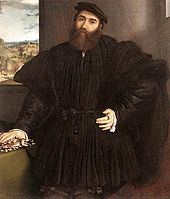- Mercurio Bua
-
 Portrait of Mercurio Bua by Lorenzo Lotto[1]
Portrait of Mercurio Bua by Lorenzo Lotto[1]
Mercurio Bua, Count of Aquino and Roccasecca (Nafplion 1478 — Treviso c.1542?) was a famed condottiero (stratioti captain) and commander of the Venetian army.Life
Flag given in 1510 to Mercurio Bua by Emperor Maximilian I. It features a double-headed eagle, symbol of both Byzantium and the Holy Roman Empire, the Cross of Burgundy and four "B"s or firesteels, used in the Palaiologos arms, but also linked to the House of Habsburg's Order of the Golden Fleece.[2]
Born in Nafplion in the Peloponnese Bua was a member of the Albanian Bua and Arianiti families.[3] His uncle Constantine Arianiti, a nobleman of the Holy Roman Empire, was the Count of Montferrat.[3] Due to his martial prowess, he was eventually made Count of Aquino and Roccasecca (of the Holy Roman Empire). In 1519, he married the Greek Maria Boccali, the daughter of Niccolò Boccali.[3] Maria died in 1524 leaving one son with the name Flavio. She was buried in Santa Maria di Treviso. In 1525 Mercurio married Elisabetta, daughter of Alvise Balbi. With her Mercurio had four children: Helena Maria, Curio, Polyxena and Alessandro. Elizabeth died in or before 1528.[4]
M. Bua died in Treviso (Italy) between 1527 and 1562 were earlier he served as Captain of a unit of 50 soldiers. He is buried in Santa Maria Maggiore in the same city. In 1562 a marble monument was erected on his tomb, made by Antonio Lombardo. In 1637 the following inscription was made on the monument:
"Mercurio Bua Comiti E. Principibus Peloponnesi
Epirotarum Equitum Ductori,
Anno Salu. MDCXXXVII."Which means "To Count Mercurio Bua, Prince of Peloponnesus, Leader of the Epirote Horsemen, Year of our Salvation, 1637". The monument also lists some of his military career.[5][6]
Bua's life and heroic achievements were hymned in a very long epic poem written in vernacular Greek language by Tzanes (Ioannes) Coroneos. The latter was born in Zakynthos (western Greek island) and is assumed that was a stratioti-troubadour. This poem was found in a manuscript in Italy and was published partially by C. Hopf and entire by K. Sathas. It was written in 1519 when Coroneos was in Venice and refers to Bua's history till 1517. It consists of about 4.500 rhyming verses and contains valuable historical information. Coroneos wrote and sent to Bua also a smaller poem (“pittakion”) of about 125 verses in Greek language, too. [7][8]Another, younger Mercurio Bua, according to a report in the Histoire des guerres civiles de France by Enrico Caterino Davila, was active in the service of the king of France in the 1580s. He was present as a commander of a unit of Albanian light cavallery at the Battle of Coutras in 1587, leading an ill-fated cavallery charge that led to his unit being diverted away from the decisive action, thus contributing to a catastrophic defeat of the royal army.[9]
References
- ^ Fossi, Gloria; Bussagli, Marco; Reiche, Mattia (2000). Italian art: painting, sculpture, architecture from the origins to the present day. Giunti Editore Firenze Italy. pp. 182â3. ISBN 8809017714. http://books.google.com/books?id=yX3VpzwQHToC&pg=PA182&dq=Mercurio+Bua&as_brr=3&hl=en&cd=7#v=onepage&q=Mercurio%20Bua&f=false.
- ^ K.N., Hellenika Anekdota, Athens, 1867, vol. 1, Original in a manuscript written by Ioannes (Tzanes) Coroneos, contemporary of M. Bua. It was studied and copied at the library of the King of Italy between 1856-1861 by various Greek researchers and published by K. N. Sathas in 1867.
- ^ a b c Bassani, Lucia Nadin (2008). Migrazioni e integrazione: il caso degli Albanesi a Venezia (1479-1552). Bulzoni. ISBN 9788878703407. http://books.google.com/books?id=akUiAQAAIAAJ&q=Boccali+Maria&dq=Boccali+Maria&hl=en&ei=2x8STZ3CKoO28QOl_dj_Bg&sa=X&oi=book_result&ct=result&resnum=7&ved=0CEAQ6AEwBjgK. Retrieved 22 December 2010.
- ^ Ricciardi Maria Luisa (1989) Lorenzo Lotto, "Il Gentiluome della Galleria Borghese", Artibus et Historiae, vol. 10, No 19, p. 96. Available through JSTOR.)
- ^ Sathas K. (1867), Andragathemata of Bua, by Tzanes Coroneos, Hellenika Anekdota, vol.1, p.123, in Greek language
- ^ Edward Hutton: Venice and Venetia. Read Books, 2009. Page 229. ISBN 1444649922. [1]
- ^ Hopf Charles (1873) Ex Jannis Coronei Rebus a Mercurio Bua gestis, in Chroniques Greco-Romanes, Librairie de Weidmann, Berlin, pp 367- 370. (Contains the first 136 verses).
- ^ Sathas K., chapter A, pp 1-153.
- ^ Davila, Enrico Caterino (1657). Histoire des guerres civiles de France. 1. Paris. p. 563. http://books.google.com/books?id=LivQeU_9QBkC&pg=PA561&dq=%22bua%22+%22Histoire+des+guerres+civiles+de+France%22+davila&hl=en&ei=N6dBTtnuLsqF-wblgq20CQ&sa=X&oi=book_result&ct=result&resnum=4&ved=0CDoQ6AEwAw#v=onepage&q=bua&f=false.
External links
Categories:- 1478 births
- 1542 deaths
- Condottieri
- People from Nafplion
- Counts of the Holy Roman Empire
- Venetian military personnel
- Bua family
Wikimedia Foundation. 2010.

